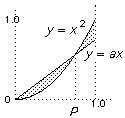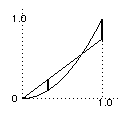Hence prove that if a sequence (fn) in C[a, b] converges to a function f in d∞ it also converges to f in d1.
Deduce that there are two points opposite one another on the equator where the temperature is the same.
Choose a point x0 and define a sequence (an) by a1= x0, an+1= f (an) for n ≥ 1. Prove that this is a Cauchy sequence and that it has a limit a which is a fixed point of f. i.e. f (a) = a.
Prove that this fixed point is unique.
The next three questions try to show you why the metric d2 is an easier one to work with than d1 or d∞.

Find the best-fit straight-line through the origin to the function x2 in the metric d1.
i.e find the value of a which minimises d1(x2, ax).
For this you have to minimise the shaded area.
Calculate this area by first finding the x-coordinate of the point P in terms of a.

Find the best-fit straight-line through the origin to the function x2 in the metric d∞.
i.e. find the value of a which minimises d∞(x2, ax).
For this you have to choose a so that the "vertical distance between the graphs" is a minimum.
From the picture, you can see that the best you can do is to adjust the value of a so that the two dark lines have equal length.